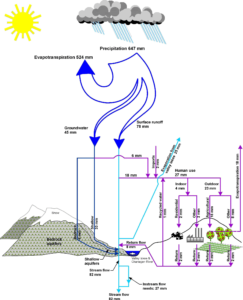The Okanagan Basin Water Accounting Model (Accounting Model) brings all parts of the Project together and is used to create a water balance within the basin.
The model estimates the effects of reservoir storage, return flows, and water withdrawals on natural streamflows, groundwater, and lake levels.
The model can be used to show how water management decisions can positively or negatively affect the entire basin, or one part of the basin, even if the water management activity is occurring in another part of the valley.
The Accounting Model can also help evaluate potential effects of climate change, population growth, water use efficiency, agricultural land base expansion, and mountain pine beetle when it is used for future scenarios.
Project Downloads:
- Summary Report – Part Three – Models (468Kb PDF)
- Appendix J Okanagan Basin Water Accounting Model (18.3Mb PDF)

